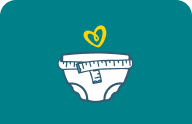Why Does Your Baby Cry During a Diaper Change? Tips to Help

Does your baby hate diaper changes or cry every time you reach for a fresh diaper? It’s common for newborns to feel uncomfortable during diaper changes, but there are ways to make the process smoother. Here’s a quick summary of how to help when your newborn screams during a diaper change:
Be prepared and gather all diapering essentials in advance to make the process quicker.
Keep your baby warm and cover their chest with a soft blanket.
Use smooth, steady movements to minimize discomfort.
Toys and eye contact may help shift their focus.
For more tips on how to make diaper changes less traumatic for newborns, follow the step-by-step guide below.
Why Does Your Baby Cry During Diaper Changes?
If your newborn cries during a diaper change, you’re not alone. Many babies react this way because diaper changes involve sudden shifts in temperature and sensation. The transition from warm clothing to cooler air may feel surprising, which often explains why a baby cries when you’re changing their diaper.
Crying is also a natural way for babies to communicate discomfort or frustration. Since they can’t express their feelings with words, crying becomes their primary way to tell you something feels unfamiliar or unpleasant. This can make it seem like your newborn hates diaper changes or is resisting them. The sensation of a cold wipe, the snugness of a diaper, or the feeling of being exposed can all contribute to fussiness during diaper time.
Your little one may also feel overstimulated by the physical handling involved. For newborns still adjusting to life outside the womb, the movements required during a diaper change—like lifting their legs—may be unfamiliar. As your little one grows, their curiosity about their surroundings may lead them to squirm or resist.
Although it may be challenging, remember that this phase is temporary. With time, patience, and gentle techniques, diaper changes can become smoother and more comfortable for both you and your little one.
Does the Crying Stop?
It’s important to remember that each baby is unique. While some babies may continue to fuss occasionally, consistency, gentle techniques, and a calming environment may help make diaper changes a more positive experience over time.
The exact timing may vary depending on the baby. All newborn babies will cry and fuss at times, especially during their first 6 weeks. Factors like sensitivity to touch, temperament, and how quickly the diaper change is completed can all play a role. To learn more, check out our Baby Development Milestones.
Baby Development Milestones Watching how your baby grows and develops is an important part of parenthood. Keep track of your little one's progress with our baby development milestones articles!
How to Help Smooth the Process?
If your little one seems distressed during diaper changes, a few simple strategies may help make the experience more comfortable. Here are some practical ways on, how to help make diaper changes less traumatic for newborns and encourage a calmer routine:
Step 1. Choose the Right Location
Select a quiet, and clean space for diaper changes. A familiar and cozy environment may help your little one feel more secure. Keep the area free of loud noises and sudden distractions, as these may startle your baby. If you find yourself outside your little one’s comfort zone, read more on our guide about changing diapers in different scenarios.
Step 2. Set Up a Comfortable Changing Pad
Use a soft, supportive changing pad to provide a gentle surface. Having a portable, foldable pad is ideal for keeping your little one clean and comfortable during changes.
Step 3. Prepare Everything in Advance
Gather all the necessary supplies before you begin. Having everything within reach helps speed up the process and reduces the risk of leaving your little one unattended.
Essential items include:
Diapers. Newborns normally use up to 10 diapers per day, so keep a good supply of diapers on hand, such as our Pampers Swaddlers. Remember that every child is different so the days may vary. Learn more about how many diapers you need in our guide.
Wipes. Choose soft, gentle wipes like our Pampers’ Baby Wipes designed for a baby’s delicate skin to help minimize irritation.
Distractions. A small toy or pacifier can help keep your little one engaged.
Diaper Bag. Stock your diaper bag with extra diapers, wipes, and a changing pad to prepare you for diaper changes while away from home. For more on what to pack check out our diaper bag checklist.
Being well-prepared allows you to change your baby’s diaper quickly and efficiently, which may help reduce fussiness and discomfort. And if you’re traveling, check out our traveling tips for more guidance.
Step 4. Gentle and Efficient Technique
Gently lift your little one’s legs with one hand, supporting their lower back to prevent discomfort, and slide an open clean diaper underneath with the other. Keep your baby warm and minimize the shock of cold air. Use gentle, smooth movements to avoid startling your baby.
It’s helpful to learn the basics of diaper changing to make the process quicker and more comfortable. Check out this step-by-step guide on how to change a diaper.
Offer comfort by speaking softly, singing, or maintaining eye contact. A toy may distract your baby and help stop your newborn from crying during diaper changes by reducing fussiness and making the process more predictable.

What is the right diaper size for your baby?

Not sure if your baby’s diaper fits quite right? From leaks to comfort, finding the right size makes all the difference! Take our quick quiz to discover the best diaper size for your little one and say goodbye to leaks. Let’s find that perfect fit!
Instant Results
Enjoyment Guaranteed
Personal Insights
The Bottom Line
Crying during diaper changes is common, especially in newborns adjusting to new sensations. By creating a warm, calm environment, using gentle techniques, and offering distractions, you can help make diaper changes less stressful. Over time, most babies become more comfortable with the process.
To make diapering more affordable, consider using the Pampers Rewards App, which offers discounts and digital deals on diapers and wipes. This can help you save while keeping your baby comfortable and dry.
How We Wrote This Article The information in this article is based on expert advice found in trusted medical and government sources, such as the American Academy of Pediatrics and the American College of Obstetricians and Gynecologists. You can find a full list of sources used for this article below. The content on this page should not replace professional medical advice. Always consult medical professionals for full diagnosis and treatment.
Review this article:
Share
Join a World of Support
through Pregnancy and Parenthood.
![toy]()
TRACK WITH TOOLS
![baby]()
LEARN WITH EXPERTS
![Gift]()
GET REWARDED

Where You Already Belong










